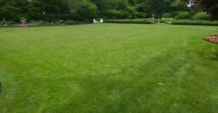After a long, hot summer we are all ready for some cooler weather, and so are our tall fescue lawns. The fall is the most important time of the year to be doing maintenance on tall fescue lawns, and you have to think F.A.S.T. – Fertilize, Aerate, Seed, & Turf Weeds. In a few short weeks we will be headed into winter and by then it will be too late in the season to do everything that needs done, so act fast as you think F.A.S.T.:
F (Fertilize): September is the most important month to fertilize tall fescue, followed by the month of November. Fertilizing during these times of the year encourages deep root growth and helps boost plant growth without unnecessary leaf growth (which just means more mowing). Use quick release, high nitrogen fertilizers, unless a soil test indicates otherwise. Fertilizer should be applied at a rate of 1 to 1½ pounds of nitrogen (N) per 1,000 square feet. The amount of actual fertilizer needed per 1,000 square feet will vary depending on the fertilizer used (remember no fertilizer is 100% nitrogen).
A (Aerate): Clay and compacted soils benefit from aeration. Core aerating machines remove small plugs of soil and leave small holes in the ground that allow for better water, air, and root penetration. September is the best time to aerate tall fescue lawns, before overseeding. You can rent an aerator from a local nursery or rental agency or hire a professional. Cores of soil brought to the surface during aeration should be left on the lawn. As they disintegrate, they fall back into the holes and help with decomposition of thatch.
S (Seed): Seeds germinate quickly, there is less weed competition, and plants can establish before periods of extreme hot or cold. The recommended seeding rate for home lawns is 6 to 8 pounds per 1,000 square feet, using good-quality seed and proper soil preparation and planting procedures. Heavy seeding can lead to overcrowding, poor rooting, and disease problems, which may eventually kill turf. If you plan to overseed a lawn, seeding rates are only 3-5 pounds per 1,000 square feet. The most important step in seeding a lawn is to keep the soil surface constantly moist until seedlings appear.
T (Turf Weeds): A healthy tall fescue lawn is fairly resistant to weed infestation. If weeds appear, the best time to control broadleaf weeds such as dandelions, chickweed, and henbit is September and October. Spring herbicide applications are not as effective and do not provide lasting results. Do not use pre-emergent herbicides if you plan to overseed or plant a new lawn. To prevent injury to newly seeded or established tall fescue lawns always follow label directions. As a general rule, avoid using broadleaf weed killers until the grass has been mowed three times after planting.




